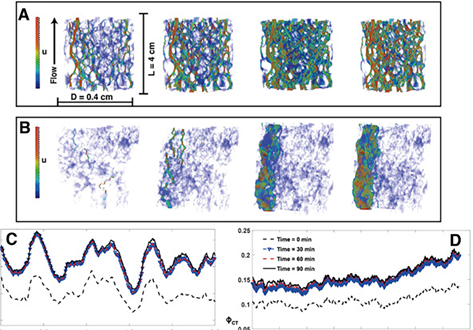4D multi-scale imaging of reactive flow in carbonates: Assessing the impact of heterogeneity on dissolution regimes using streamlines at multiple length scales

We have experimentally investigated the impact of heterogeneity on the dissolution of two limestones, characterised by distinct degrees of flow heterogeneity at both the pore and core scales. The two rocks were reacted with reservoir-condition CO2-saturated brine at both scales and scanned dynamically during dissolution. First, 1 cm long 4 mm diameter cores were scanned during reactive flow with a 4 μm voxel size between 10 and 71 times using 4D X-ray micro-tomography (μ-CT) over the course of 90 min. Second, 3.8 cm diameter, 8 cm long cores were reacted at the same conditions inside a reservoir-condition flow apparatus and imaged using a medical-grade X-ray computed tomography scanner (XCT). Each sample was imaged ~13 times over the course of 90 min at a 250 × 250 × 500 μm resolution. These larger cores were then scanned inside a μ-CT at a 27 μm voxel size to assess the alteration pore-space heterogeneity after reaction. Both rock types exhibited channel widening at the mm scale and progressive high porosity pathway dissolution at the cm scale. In the more heterogeneous rock, dissolution was more focussed and progressed along the direction of flow. Additionally, the dissolution pathways contained a distinct microstructurecaptured with the μ-CT that was not visible at the resolution of the XCT, where the reactive fluid had not completely dissolved the internal pore-structure. This microstructure was further analyzed by performing a direct simulation of the flow field and streamline tracing on the image voxels.
We found that at the larger scales the interplay between flow and reaction significantly affects flow in the unreacted regions of the core. When flow is focussed in large reacted channels, this focusing is carried through to the unreacted parts of the rock where flow continues to be confined to preferential pathways after passing the reaction front. This focussing effect is greater with increasing pore space heterogeneity indicating that the representative elementary volume (REV) for dissolution is far greater than the dissolution front itself. This study of scale dependence using in situ 4D tomography provides insight into the mechanisms that control local reaction rates at the mm and cm scales. Furthermore, this work suggests that under these conditions at larger scales it is likely to be structural heterogeneity that dominates the pattern of dissolution and therefore the evolution of high permeability pathways.